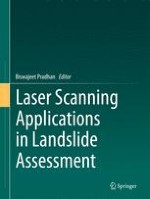2017 | OriginalPaper | Chapter
12. Slope Vulnerability and Risk Assessment Using High-Resolution Airborne Laser Scanning Data
Authors : Biswajeet Pradhan, Norbazlan Mohd Yusof
Published in: Laser Scanning Applications in Landslide Assessment
Publisher: Springer International Publishing
Activate our intelligent search to find suitable subject content or patents.
Select sections of text to find matching patents with Artificial Intelligence. powered by
Select sections of text to find additional relevant content using AI-assisted search. powered by
